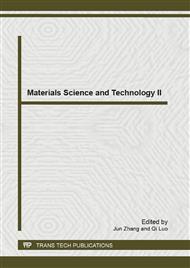p.30
p.36
p.40
p.44
p.50
p.54
p.58
p.62
p.66
Resonance Rayleigh Scattering Study of the Interaction between Surfactant and Silver Nanoparticles
Abstract:
In the presence of sodium dodecyl benzene sulfate (SDBS) and under the irradiation of microwave, silver nitrate was reduced by alcohol to prepare stabile green and yellow silver nanoparticles in size of 41 nm and 71 nm respectively. Yellow silver nanoparticles have two resonance Rayleigh scattering (RRS) peaks at 440nm and 465nm. Green silver nanoparticles exhibit three RRS peaks at 420nm, 465nm and 585nm. Gray nanoparticles, which prepared in absence of SDBS, show a strong RRS at 465nm. Silver nanoparticles modified by dodecyl benzene sulfate (DBS) can react with cationic surfactant to exhibit novel RRS property. The concentration of some cationic surfactants is liner to the enhanced RRS intensity at 465nm.
Info:
Periodical:
Pages:
50-53
Citation:
Online since:
July 2013
Authors:
Price:
Сopyright:
© 2013 Trans Tech Publications Ltd. All Rights Reserved
Share:
Citation:


